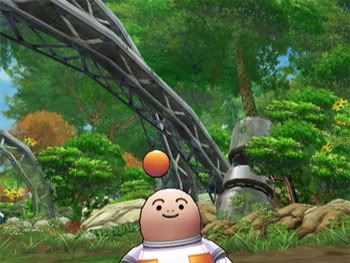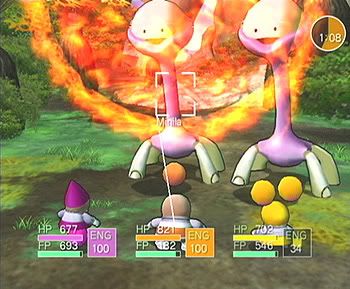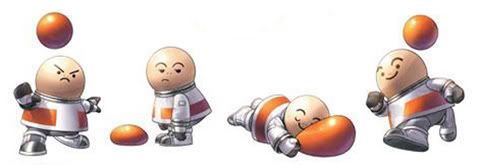
Opoona
Genre: RPG
Developer: ArtePiazza
Publisher: Koei
Release Date: 03/25/2008
Okay, let’s review Opoona. What the hell’s an Opoona you ask? Well, it’s an RPG with a somewhat unfortunate name, starring characters who do battle with their balls. Not ringing a bell? I’ll forgive you for not knowing what it is since the game’s been a pretty massive flop, only selling around 40,000 copies worldwide since its release over a year ago.
So why the heck did I buy an old, unpopular game with a vaguely filthy sounding name anyways? Well for one, the game goes for 20 bucks new these days (assuming you can actually find a copy). Secondly, the game is developed by ArtePiazza, the company behind the recent DS Dragon Quest remakes I’ve been gushing over lately, so surely it couldn’t be all bad. Could it?
1) Story
The star of the game, Opoona, is a young child and a member of an overly adorable race of aliens tasked with defending the universe. You and your family are on a vacation, when your spaceship malfunctions under mysterious circumstances causing you to crash land on the planet of Landroll, which is populated by a futuristic human-like society. You’re separated from your siblings, your parents (imaginatively named Mameena and Dadeena) are injured in the crash and it’s up to you make your way in the world and bring your family back together happy and healthy.
That’s your set up, and for quite a while that’s all you get. You’ll get little snippets of information and meet characters who will be important later, but it isn’t until about halfway through the game that these threads start to tie together into a real plot. Even then the story remains a fairly simple affair (although there are a couple decent twists). The focus here isn’t on the overarching plot, but on relationships you build with individuals, and watching their various small dramas play out. The overall storyline may not be exactly epic, but those who really delve into Landroll will find a world that’s actually exceptionally deep and complex.
Unfortunately it’s all undermined a bit by a mediocre translation. While I commend Koei for bringing this strange little game to North America at all, the publisher isn’t really known for handling RPGs, or well, the quality of their translations in general. It’s certainly not terrible. Any old codgers who lived through the 8 and 16-bit eras have seen much worse, but there are occasional grammatical errors, moments of awkward phrasing and most of the humor has been steamrolled out of the script. The story would be in the good to very good range with a better translation.
Story Rating: Enjoyable
2) Graphics
Unfortunately Opoona’s graphics are going to immediately turn-off around 90% of prospective players (and based on the scores the game’s picked up, that includes pro-reviewers). Obviously Opoona and his family are simple in the extreme, and that can be chalked up to intentional stylization, but where things get ugly is with the human-like NPCs, which look like something you might have seen on the N64. Aside from being a bit sharper, that’s not an exaggeration.

The environments are thankfully an improvement, in that they look like Dreamcast rather than N64 quality. The environments do occasionally impress though. The main thing they have going for them is an impressive sense of size and scale; climbing to a high point in one of the domes and being able to see the whole city down below you is pretty impressive. Some of the later areas such as the fairy forest and underwater dungeon are actually quite pretty too, although you have to play through a number of somewhat bland earlier areas before you’re rewarded with them.
All in all, while the game isn’t a technical masterpiece, it’s not without its charm and I’d rate it higher if it looked as clean and nice as it does in the official Koei screenshots. Unfortunately it doesn’t. The game doesn’t support widescreen or 480p and there’s a real problem with jaggies, especially on an HD TV. A lot of the appeal of the intentionally simplified character designs are lost when your main character’s a mess of jaggies and stray pixels.
Graphics Rating: Mediocre
3) Sound
Opoona’s soundtrack is the work of Hitoshi Sakimoto, the legendary game composer behind everything from Gauntlet, to all the Ogre games, to Final Fantasy XII. I won’t over exaggerate and say this is his best work, but the quality of Opoona’s music is so far and above its visuals that they almost seem to be from a different game. The songs mix modern electronic music with lots of strings and classical sounds, and while not every track is a gem, some of them are strikingly beautiful.
Sound effects on the other hand are solid, and the game is completely devoid of any voicework. This didn’t bother me much as Opoona is such a strange little bugger it would be almost impossible to find a voice that would really fit. I imagine if they tried he and his family probably would’ve ended up sounding like the Toads from the Mario games or something, and that’s something nobody wants to listen to for 30 hours.
Sound Rating: Incredible
4) Control and Gameplay
Koei describes Opoona as a “Lifestyle RPG”Â, which, I suppose, is about as accurate a description as any, since you spend as much time hanging around in the game’s large cities (referred to as “domes”Â) as you do hacking through dungeons. While in the domes your main goal is to collect occupational licenses, which range from your main Ranger license to more exotic ones like Fortuneteller, TV Dance Sensation or Master of the Ukulele. Once you have a license completing certain jobs will allow you to trade it in for a higher ranking license, which in turn gives you access to more jobs and so on. Collecting new licenses and completing jobs not only nets you stat bonuses and cash rewards, but also opens up new areas to explore, making certain licenses integral to progressing in the game. Want to poke around the television station? Better get a Star license first. Need a ride on a cuddly dolphin’s back to get into a certain dungeon? Better get that Seamaster license.
Connected to the license system is the Friend system. You’ll be able to make friends with a number of different characters, and increasing your friendship level by completing tasks for them, or simply by talking to them a lot, is almost as essential to getting by on Landroll as collecting licenses. Opening up some areas and getting certain items can require navigating quite a tangled web of different jobs and interrelated friendships, but that complexity is largely what brings Opoona’s world to life.
Yes, there’s also a more traditional side to Opoona as well, in which you’ll find yourself navigating dungeons and taking part in random battles (yes, they stuck with random battles unfortunately). The dungeons are pretty simple with little in the way of puzzle solving or even any serious exploration required for the most part. You’re usually stuck to a fairly confined path, which will branch occasionally, but never to the point of becoming particularly complex.

The battle system on the other hand is far more inspired. Upon entering battle you’ll likely notice how streamlined things are, with you only being given the option to attack, use an item or use magic (referred to a “Force” in Opoona). Even the almost universal RPG options to defend or flee from battle have been removed.
Opoona (and later his siblings) attack enemies using the balls floating above their heads, which are called Bonbons (ain’t that just precious?) Pulling the analog stick in any direction will charge your Bonbon and releasing it will fire it off at the enemy. Sounds simple, but there’s actually some depth to it. The longer you charge up your Bonbon, the faster it will fly, and the more damage it will do, but it will also take longer for you to recharge leaving your vulnerable. Opoona’s battles also take place in real time (enemies won’t even stop attacking as you navigate menus) so timing is important. Fire off your Bonbon too early or late and you may miss an enemy altogether, but if you time things right you may nail them just as they’re getting ready to attack, cutting them off (which is basically your only form of defense in the game). There’s more still, as pushing different directions on the analog stick will allow you to hook your Bonbon left or right or throw an underhand shot, which you’ll need to do to hit the weak spots of some shielded or flying enemies.
By comparison, using Items or Force abilities is pretty standard stuff, although you have to time things properly and choose what you want quickly since, as already mentioned, the bad guys can beat on you even as you’re selecting your healing potion or fire attack from the menu. One final strange wrinkle; every battle in Opoona has a time limit (of usually 2 minutes) and if you don’t finish your opponent off in that time, you lose. Back to your last save point. This may sound harsh, but Opoona’s battles go by in a flash, often taking no more than 5 seconds, so you’ll almost never go over the limit. Overall the battle system is unique, fast and far more action oriented than most JRPGs without ever feeling like a hackfest (I’m looking at you Tales games).
Finally let’s briefly touch on controls. Prior to its release the most hyped aspect of Opoona was your ability to control the game using only the nunchuck. Woooooo! Of course anyone who’s picked up a Wii controller knows this is a rather silly “feature” since the nunchuck has to be plugged into the Wiimote to work in the first place. Furthermore for most folks you’re either stuck playing with only with your weak left-hand, which feels awkward, or switching the nunchuck to your right hand, which also feels awkward after years of always manipulating the analog stick with your left hand. Thankfully all the functions crammed onto the nunchuck are also mapped to the Wiimote and playing with both the nunchuck and Wiimote feels just fine. Even better, the game supports the classic controller, which feels best of all. Somehow playing RPGs with a SNES-esque controller just feels right, ya know?
Control and Gameplay Rating: Great
5) Replayability
Don’t let the Fischer-Price exterior fool you, this is a deep game with a main quest that will take you around 30-hours to complete (and that’s only if you manage to stay fairly focused). Folks who want to max out all their friendships and get all the job licenses could potentially spend double that time.
Replayability Rating: Amazing
6) Balance
Opoona is, for the most part, a pretty easy game. You’ll blow through the vast majority of battles, but the opposite is also true. If you find yourself out of your league you may find your party crushed within about 10 or 15-seconds, which can be frustrating, particularly when it’s a boss at an end of a dungeon that offed you.

Thankfully ArtePiazza has learned a thing or two working on the Dragon Quest series. As in the DQ games, dying isn’t really “Game Over”Â. Instead you’re simply taken back to the last place you saved, with all the items and experience you collected still intact. In fact the punishment for dying in Opoona is even less strict than in Dragon Quest; in Opoona only a small fee is extracted from you when your party is defeated (as opposed to having half you gold taken). Just as in Dragon Quest, being able to keep your experience means there’s rarely any need for leveling, your characters increase in power naturally as you take multiple runs at a dungeon.
Balance Rating: Good
7) Originality
You’ve never played another RPG quite like Opoona, and if it’s success (or lack thereof) is any indication, you’ll probably never get the chance again. While a fairly traditional JRPG in some ways, it stands out in a genre where most developers think changing the hairstyle of their stock brooding effeminate teenage protagonist passes as originality.
Originality Rating: Great
8) Addictiveness
I found this game pretty damn engrossing, even when it was driving me freakin’ nuts. Finishing certain jobs or pumping up some friendships can be a bit mind-numbing to say the least, and yet there I was in front of my TV until 3 in the morning trying to complete them. If you give it a chance, and are able to ignore some of its idiosyncrasies, the deep, involving world of Opoona just might draw you in too.
Addictiveness Rating: Incredible
9) Appeal Factor
The writing’s pretty much already on the wall for this category since, as already mentioned, the game’s only managed to sell around 40 thousand copies worldwide. In many ways Opoona is a very old-school design. The game isn’t packed with distracting cut scenes or a lavish story, you’re pretty much set free to explore the world and figure out the game’s mechanics on your own, sometimes without a lot of guidance. That’s something a lot of old-school RPG fans will be familiar with, but will these old geezers tolerate the cutesy presentation? It definitely hit a sweet spot for me as I dig both old-school RPGs, and social sims like Harvest Moon and Animal Crossing, but I realize that’s a pretty slim niche.
Appeal Factor Rating: Mediocre
10) Miscellaneous

Good God I’ve been rambling on about this game for too long. Can I stop now? Please?
What more is there to say? This is a game where a child with a candy floating over his head can become friends with a woman who wears a thong wherever she goes by becoming the greatest breakdancer in the galaxy. Does that sound like the kind of game you’d like to play? Well, does it? Of course it does. Now let’s wrap this up.
Miscellaneous Rating: Classic
The Scores
Story/Modes: Enjoyable
Graphics: Mediocre
Sound: Incredible
Control and Gameplay: Great
Replayability: Amazing
Balance: Good
Originality: Great
Addictiveness: Incredible
Appeal Factor: Mediocre
Miscellaneous: Classic
Final Score: Great Game
Short Attention Span Summary
Opoona is not always an easy game to like. It’s ugly, it’s weird, it’s sometimes obtuse. That said, if you give it a chance, you’ll find a game that’s also unique, absorbing, surprisingly deep and just plain endearing. It’s a game that’s built on a solid traditional JRPG foundation, yet there’ll probably never be anything quite like it again. As of now, it’s probably still the best RPG on the Wii, and with it selling for dirt-cheap these days, RPG fans don’t have much to lose. Give this poor breakdancing alien a home.
Leave a Reply